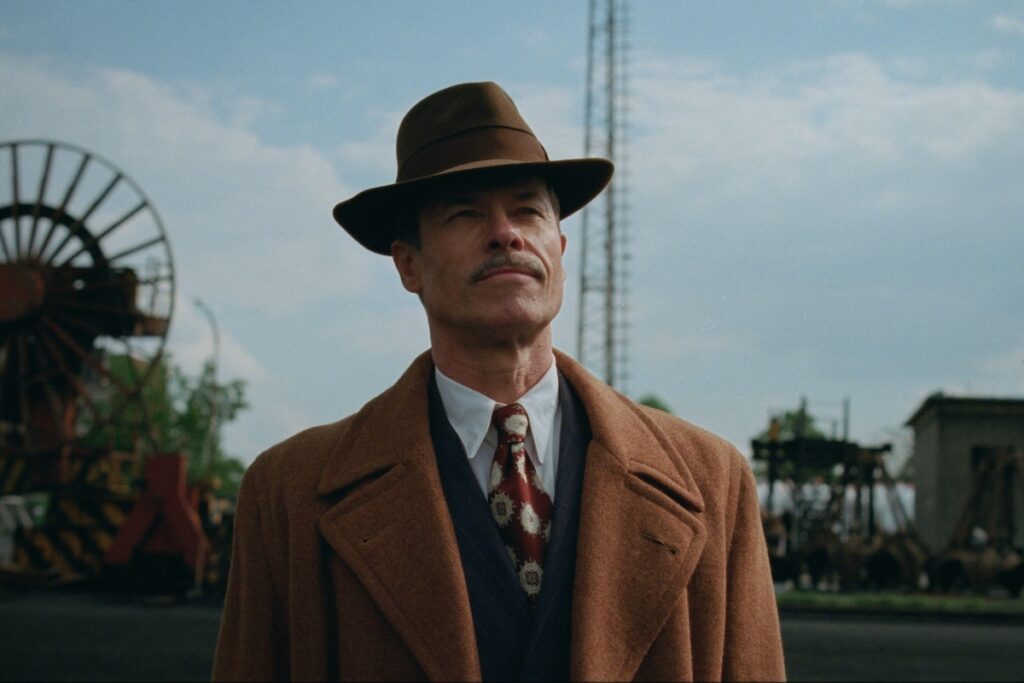The Year’s Most Ambitious Movie, ‘The Brutalist,’ Is a Monument to Art, Perseverance, and Legacy
The drama clocks in at more than three and a half hours, with a 15-minute intermission for viewers who could use a break from the cinematic largesse.

Unarguably the most ambitious movie of the year, “The Brutalist” arrives on Wednesday for one night only at AMC Lincoln Square’s IMAX theater, while starting Thursday filmgoers can experience it at additional theaters, with both standard screenings and special 70mm engagements that complement the filmmakers’ use of Vista Vision, a visually crisp, wide-view format first used in “White Christmas.”
The large-screen presentation suits a film that delves into major topics such as post-World War II trauma, the immigrant experience, drug addiction, sexual assault, the corrupting power of money, and the psychology of architecture. Another example of its grandiosity is its running time: The drama clocks in at more than three and a half hours, with a 15-minute intermission for viewers who could use a break from the cinematic largesse.
Director and co-writer Brady Corbet, a one-time actor, has stated that his inspiration for the film sprung from his interest in how Brutalist architecture originated in building methods and materials established for war, as well as his fascination with the Bauhaus-adjacent style’s major proponents, particularly Marcel Breuer (of Met Breuer fame, or infamy). Mr. Corbet’s protagonist and “Brutalist,” though, is a fictional Jewish architect named László Tóth, played by Adrien Brody.
A respected modernist in his home country of Hungary, László after World War II comes to America, where it’s difficult to find meaningful work until he crosses paths with a wealthy industrialist, Harrison Lee Van Buren. Although fairly friendly as portrayed by Guy Pearce, Harrison could also be considered a “Brutalist,” as the film bears out.

Presented in two acts, the feature’s first part follows László as he arrives at New York via boat, heads to Pennsylvania to work in his cousin Attila’s furniture store, designs a special study for Harrison’s mansion at Doylestown, gets fired and thrown out onto the streets by Attila, becomes addicted to heroin, and receives a commission from Harrison to design a multi-functional community center.
Those major plot points, though, describe only half the story; the expressive imagery, stylistic touches, and layers of sound design tell the rest. Examples include an upside-down shot of the Statue of Liberty; vintage promotional footage of Pennsylvania industry; and audio overlays of radio news, including coverage of the 1947 United Nations resolution creating the state of Israel.
Individual scenes and sequences stand out, such as the construction of Harrison’s study, which transforms the old, stuffy library into a vision of minimalism and elegance, and when Harrison reconnects with László in a diner and awkwardly declares their conversation “intellectually stimulating.” Others, like nearly every scene involving László, Attila, and his cousin’s wife, feel drawn out in order to create melodrama.
Once our hero is welcomed into Harrison’s world of dinner parties and influential friends, the film’s uneasy satire of the rich and powerful continues this airless quality, with drama at the building site feeling manufactured as well. One curious scene has Harrison sitting near Solomonic columns and telling a long story of cruelty in which he was the perpetrator; László approves, perhaps out of respect for his host.
The second act deepens the film’s themes while also cluttering its design, as László’s wife Erzsébet arrives from Europe in a wheelchair, with niece Zsófia in tow. If one gets used to Felicity Jones’s Eastern European accent as Erzsébet, her performance emerges as one of the most emotionally rigorous in the film. Sensing the moral rot surrounding Harrison and his circle, she takes a job at New York. Before long, László joins her there after the entire community center project is abandoned following a train derailment.
During a dinner in their New York apartment, with the camera slowly approaching the table, a pregnant Zsófia announces she and her husband will be moving to Jerusalem, bringing the theme of Jewish identity to the fore. A Holocaust survivor, Mr. Brody’s László could be seen as a continuation of the actor’s Oscar-winning portrayal of Władysław Szpilman in “The Pianist.”
As Harrison, Mr. Pearce embodies a businessman who, though not a philistine, must come off as gruff and smug. The actor is sinisterly effective, and during an interlude in the marble caves of Carrara, Italy, after construction on the community center is resumed, the character’s hitherto unexplored sexual side is shockingly revealed.
The plot erected by Mr. Corbet, along with co-writer/partner Mona Fastvold, fastens on many additional issues, such as filial corruption, infidelity, and racism, yet his writerly grasp exceeds his ability as director to make certain scenes work, or to build up to a climax. Still, his sense of scope remains more than admirable, and the level of sophistication of the cinematography, production design, audio approach, and musical score merits accolades and awards.
With its epilogue, set in 1980, “The Brutalist” turns what seemed to be the tragic tale of an immigrant artist in America into a triumphant metaphor of subversion, dignity, legacy, and creative freedom. It’s a sly, almost glib move on Mr. Corbet’s part, and one that nearly undercuts everything we’ve witnessed beforehand. Yet this conclusion also compels the viewer to wander back through all of the film’s thematic halls and chambers — to search not only for narrative clues but for László’s wisdom and divine khen.
Correction: Adrien Brody is the correct spelling of the actor’s name. An earlier version contained a misspelling.

